Very often parts do not fit well or they must be shaped, smoothed, cleaned or polished by removing material. Although metallic cutting tools can be used; sanding, stoning, wire brushing and buffing, abrasive methods can achieve smoother results. Abrasives consist of very tiny, closely spaced chisel edges on grains of hard crystalline substances, usually oxides or diamonds. They may be bonded together or on backings. Some are suspended in pastes, gels or liquids. Sorted by sieving, grits are rated by number per inch or for finer ones, actual size in microns (1 millionth of an inch). The end of bristles on brushes can also act as small chisels to perform similar functions. Even the fibers in cloth make up fine chisels. They all use these fine chisels to remove material.
Commonly called sanding, one method uses an abrasive grit bonded to a flexible or stiff backing material like paper, cloth, plastic, wood or metal. Some are used with water or other lubricants to improve cutting and finish. Grits run from very coarse 20 per inch to extremely fine microns. Coarser grits cut faster and deeper, but often leave scratches, which require successively finer applications to remove. Often referred to as rouges, very fine grits can produce highly polished finishes. Tr eatable materials include wood, plastic, metal and glass.
The most common backing is sheet form in many sizes. Some are precut into strips, shapes, rolls or belts for specific applications. Paper is least expensive, but does not wear well, cracks or tears when bent, and can not be used with water. Commonly used in belts, cloth backings are thicker, flexible and longer lasting . Some are sold in rolls for use in plumbing to prepare solder fittings. Sheets known as crocus cloth have a very fine abrasive, used to polish electrical contacts. Thin plastic backings are very flexible and can be formed to fit many tools. For general model use the best is FLEXI-GRIT with a grit range from 80 to 0.5 micron, in assortment packs with sheet size 4" x5.5". Larger sheets are available at better hobbyshops.
Almost any can be used by fingers or trimmed sheets can be wrapped around any solid, such as blocks, dowels and sticks; but for more convenience specialized holders are available. Cutting large sheets to form will dull cutter rapidly.
NOTE: Emery or other carbide grits should not be used on electrical parts. Carbon is a conductor, which can cause shorts.
Several types of block sanders are offered for larger surface work. In most cases, soft foam rubber pads can be affixed for contour sanding.
An old design by X-acto comes 5" long, in 1" and 2" widths, with a wedge to secure strip. Often with hard use and side force, paper works loose.

Note: Adjust brightness and contrast for optimum viewing.
X-ACTO SANDING BLOCK
Handier is the 4" x 1 3/8" ADC block with an internal ratchet for tightening. Various grit, precut strips are available .

Note Adjust brightness and contrast for optimum viewing.
ADC SANDING BLOCK
For groove and fillet sanding, contour sanders can fit in many tight places. Cut Flexi-grit sheets wrap around 5 3/8" shaped bars and are wedged into handle to hold. Working edges are narrow rectangular, wide T, small and large round and right angle V..
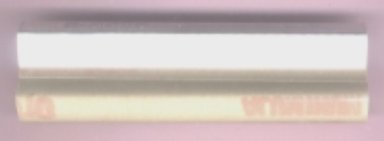
Note Adjust brightness and contrast for optimum viewing.
ROUND CONTOUR SANDER
Commonly used in building model airplanes , up to 18" T bars are useful for leveling large surfaces.
For tighter spaces sanding sticks are common. Home-made can use popsicle, lath, or any shaped stick with a cut to fit sanding sheet.
Commercial 5" long, wooden types, of various sizes and cross section like round, oval, triangular rectangular and square, have glued-on abrasive, but durability is poor on harder materials. Grit ranges are limited. Larger, more durable and expensive types are available.

Note Adjust brightness and contrast for optimum viewing.
FLAT WOODEN STICK W/ DIFFERENT GRITS ON OPPOSITE SIDES.
ROUND COMMERCIAL STICK
Flexible sticks are useful on flat, convex and concave surfaces. A newer type with a flexible core comes in 150, 280, 320 and 600 grits and three grit polisher..

Note Adjust brightness and contrast for optimum viewing.
FLEX-PAD STICKS
Very handy are 6 1/4" x 1/4" sanding sticks with replaceable, color coded belts of grits from 120 to 600. Inexpensive spring loaded, color coded, plastic handles permit readily identifiable grit swaps. Length permits straightening edges for better fit. A 1/2" wide flexible version is also available for contour sanding.

Note Adjust brightness and contrast for optimum viewing.
BELT SANDING STICK.
In cosmetic areas, inexpensive fingernail boards come in various forms with different, fine grits on each side. Commonly called emery boards, abrasive coated, cardboard or plastic sticks can be trimmed to fit tight spaces. Other nail files have fine abrasives bonded to a metal surface, similar to diamond files. Broad and flat, they are excellent for leveling wider surfaces.

Note Adjust brightness and contrast for optimum viewing.
6 1/4" FINGERNAIL EMERY BOARD
2 7/8" FINGERNAIL FILE
The newer diamond "files" are actually sanders which cut in any direction; as opposed to files, which cut in only one, if used correctly. They are available in several grits in almost all swiss pattern file shapes. A very small round file that can fit in real tight spaces, comes with a chuck handle. Many of the rotary tool, diamond bits can be chucked in a pinvise for use in tight spaces.

Note Adjust brightness and contrast for optimum viewing.
DIAMOND SWISS PATTERN FILE (SANDER)
FINE ROUND FILE W/ HANDLE
Many foam rubber pad sanders are found in super markets in the form of pot scrubbers. Hobby shops stock these with a variety of grits. They are very useful in rough contour work and removing oxides and finishes.
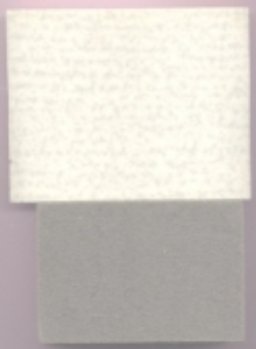
Note Adjust brightness and contrast for optimum viewing.
KITCHEN POT SCRUBBER PADS
3 3/4" x 4 3/4" x 316" thick.
2 3/4" x 4" x 1" thick.
Erasers of all types provide a variety of abrasives which can be used in many applications like removing tarnish or lettering in small areas. Since they are very soft, art gum blocks can remove blemishes and marks without damaging surface. Most older rubber ink and pencil were filled with abrasives which work well. Most of the newer types are useless, even for erasing on paper. For more convenience many are on or in sticks (pencils). Old mechanical pencils make excellent handles for replaceable erasers. Some are solely erasers, like the stenographer's which can be pointed in a standard pencil sharpener . Others are in feedable tubes. A similar handle, with locking collet to hold abrasive sticks, is better for heavier work. For work around rivets and details an adjustable fiber glass brush is very effective especially on metal.
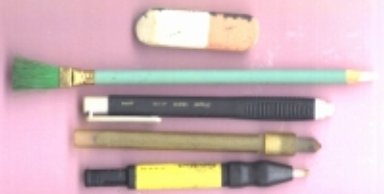
Note Adjust brightness and contrast for optimum viewing.
ERASERS.
Pen/pencil.
Stenographer's w/ brush.
Auto-feed.
Abrasive stick holder.
Adjustable fiberglass brush.
For tight, hard to reach places a 4 1/4" x 3 3/4", spring frame, holds 1/4", 150 to 600 grit, looped end bands in flat grooves.
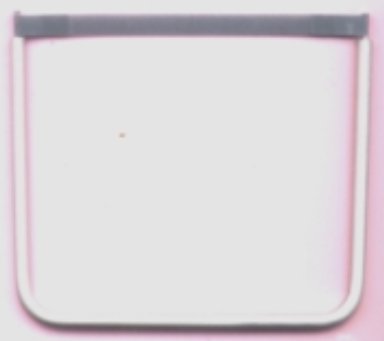
Note Adjust brightness and contrast for optimum viewing.
FLEX-I-FILE
For tighter places, machinist's abrasive cord or tape comes in grits from 120 to 280. Cord runs from .012" to .150" and tapes from 1.5" to 8.32. These are used like dental floss and can be used freehand on a lathe to polish grooves. Many carpet threads and strings are abrasive enough for polishing. These can be tied or clamped on many jeweler's saws for better control.

Note Adjust brightness and contrast for optimum viewing.
ABRASIVE CORD
BACK TO POWER ABRASIVE SHAPERS
For fine finishes and polishing, several types of abrasives are available. Although not considered a sander, fine #0000 steel wool can remove oxides and polish metals. It also removes wood fuzz raised by sanding sealers and polishes wood to resemble metal when painted after sealing.
Available in pastes, Dremel offers jeweler's rouges in jars, which can be applied with a soft cloth or cotton ball to produce polished finishes. More often they are used on buffing wheels. For machinists and jewelers, they are also available in bar or stick forms from Foredom. An old stand-by, volcanic rock pumice may be found in both solid or powdered form. Many scouring powders work well. In a pinch, many tooth pastes contain abrasives that can produce a well polished finish. These abrasives can be used with fine sponges and almost any cloth sheet, tape or string.
For very fine finishes, restoring transparency, removing blemishes, and polishing, the Micro-Surface kit offers 2 7/8" x 4" abrasive sheets and 1 7/8" x 1 7/8" double sided pads with grits from 120 to 6000. A foam rubber block pad is included for sheets. A liquid rouge is included for polishing clear acrylics.
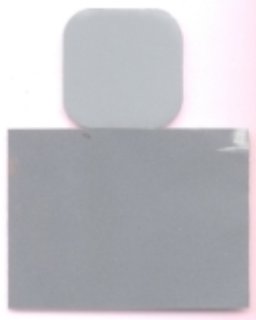
Note Adjust brightness and contrast for optimum viewing.
MICRO-SURFACE PADS
For accurate sanding to fit parts, when splicing or assembling, the NWSL True sander is hard to beat. Holding abrasive 1 1/4" or 1 3/4" strips on any of four sides, an aluminum block slides against a straight edge assuring an accurate pass. Abrasive is recessed to avoid rubbing against and wearing guide edge. A perpendicular guidebar with clamps holds triangular guides for angle sanding. A simple miter slides in a groove for easier setup of odd angles.

Note Adjust brightness and contrast for optimum viewing.
TRUE SANDER
Unfortunately after ruining a roof splice on a Bethlehem Car Works PRR B-60 baggage car, it was found that the guide bar was not true. This is evident in the image, where an angle bar is clamped true using a machinist's square. Note the gap increase toward the right.
SHARPENING, honing, whetting and stroppimg are similar to sanding and grinding, but usually more specialized tools are required, with solid porous cut stone or bonded abrasives, roughened steel or strips of leather. Although, in an emergency some of the abrasive tools can be used, much better results can be attained with tools and materials designed for the purpose.
Brushes are fine chisels bundled in a group, which can work their way around raised or lowered detail, where others fail. Brass, steel or fiberglass bushes can cut rapidly to remove oxides, paint and other materials. Very handy, to remove tarnish and blemishes in tight places, is a screw fed fiberglass in a handle. Softer, stiff typewriter cleaning brushes work well on plastics and harder woods. Tooth brushes come in a variety of stiffnesses. For larger areas soft brass suede brushes are handy. Finer bristle brushes work well with rouge. Softer bushes can be used for buffing in detailed areas on softer materials.
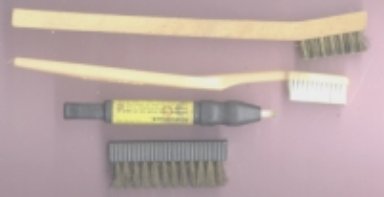
Note Adjust brightness and contrast for optimum viewing.
BRUSHES
Brass wire.
Feedable fiberglass.
Tooth.
Suede.
For faster and lazier work, POWER ABRASIVE SHAPERS _ are available in many types.
BACK TO FILES
BACK TO METHODS INDEX
BACK TO TOOLS INDEX
